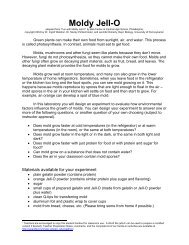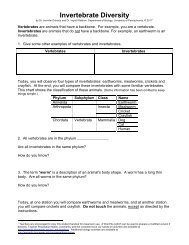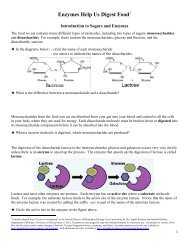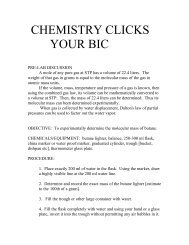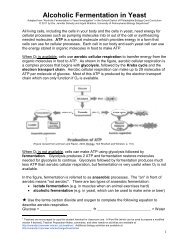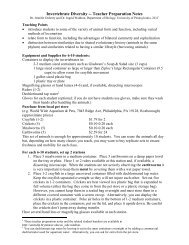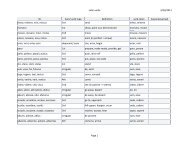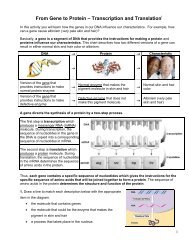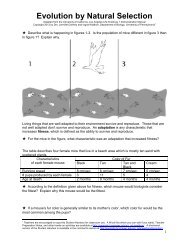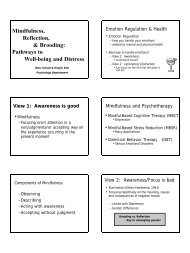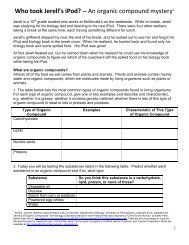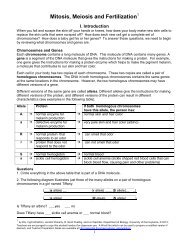From Gene to Protein -- Transcription and Translation ... - Serendip
From Gene to Protein -- Transcription and Translation ... - Serendip
From Gene to Protein -- Transcription and Translation ... - Serendip
You also want an ePaper? Increase the reach of your titles
YUMPU automatically turns print PDFs into web optimized ePapers that Google loves.
<strong>to</strong>urists goes in<strong>to</strong> a restaurant in China <strong>and</strong> each one wants <strong>to</strong> order his or her favorite Chinese dish.<br />
Suppose the <strong>to</strong>urists only speak English, <strong>and</strong> the cook only speaks Chinese. It will be very helpful <strong>to</strong><br />
have a waiter who underst<strong>and</strong>s English <strong>and</strong> can speak Chinese, so he can serve as a transla<strong>to</strong>r. The<br />
<strong>to</strong>urists are equivalent <strong>to</strong> the mRNA which specifies which amino acids should be incorporated in<br />
which position in the growing protein molecule, <strong>and</strong> the cook is equivalent <strong>to</strong> the cy<strong>to</strong>plasm which<br />
provides the different types of amino acids. The waiter is equivalent <strong>to</strong> the tRNA molecules which<br />
bring the right amino acids <strong>to</strong> the right locations.<br />
Sickle Cell Hemoglobin <strong>and</strong> Sickle Cell Anemia<br />
This section of the activity discusses transcription <strong>and</strong> translation of the beginning of the gene for the<br />
beta globin polypeptides in the hemoglobin tetramer protein <strong>and</strong> ignores the gene for the alpha globin<br />
polypeptides. The alpha globin gene <strong>and</strong> polypeptides are the same in normal <strong>and</strong> sickle cell<br />
hemoglobin. You may want <strong>to</strong> explain that the lower solubility of nonpolar valine in the watery<br />
cy<strong>to</strong>sol of the red blood cell (compared <strong>to</strong> the high solubility of ionic glutamic acid) contributes <strong>to</strong> the<br />
tendency of sickle cell hemoglobin <strong>to</strong> clump <strong>to</strong>gether in long rods inside the red blood cells. This<br />
difference in the solubility of amino acid 6 is crucial because amino acid 6 is on the outside of the<br />
hemoglobin molecule.<br />
This section of the activity summarizes the effects of homozygous sickle cell alleles, resulting in sickle<br />
cell anemia. Even in a person who has severe sickle cell anemia, most red blood cells are not sickled<br />
most of the time. Variation in the degree of clumping of sickle cell hemoglobin in<strong>to</strong> rods, sickling of<br />
red blood cells, <strong>and</strong> consequent symp<strong>to</strong>ms is influenced by multiple fac<strong>to</strong>rs, including oxygen levels in<br />
the blood, dehydration, <strong>and</strong> multiple genetic fac<strong>to</strong>rs.<br />
Sickling crises that block the blood flow in some of the small blood vessels result in pain <strong>and</strong> organ<br />
damage. The causes of these crises are often unknown, but some sickling crises are triggered by an<br />
infection that induces vomiting <strong>and</strong> diarrhea which can result in dehydration; dehydration increases the<br />
concentration of hemoglobin in red blood cells <strong>and</strong> thus increases the tendency of sickle cell<br />
hemoglobin <strong>to</strong> clump in<strong>to</strong> long rods, resulting in the sickling <strong>and</strong> other irregular shapes of red blood<br />
cells that cause blockage of the small blood vessels.<br />
7



